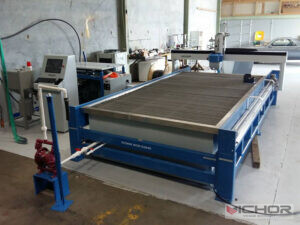Is a CNC Jet the Right Tool for Your Manufacturing Needs?
When high-precision manufacturing is the topic, one technology consistently rises to the top: the CNC jet. But what exactly is this powerful tool, and could it be the key to unlocking new levels of efficiency and capability in your production line? Far from being a niche solution, this technology has revolutionized how we cut and shape a vast array of materials. This article dives deep into the world of CNC jet systems, breaking down their core principles, advantages, and ideal applications to help you make an informed decision.
What Exactly is a CNC Jet?
At its core, a CNC jet is a computer-numerically-controlled machine that uses a high-velocity stream of fluid to cut, clean, or surface-treat materials. The term “CNC jet” is a broad umbrella, but it most commonly refers to two dominant technologies: waterjet cutting and abrasive waterjet cutting. A pure waterjet uses a supersonic stream of water, often mixed with a additive, to cut soft materials. When the task requires slicing through harder substances like metal or stone, an abrasive, typically garnet, is introduced into the stream, transforming the water into an incredibly powerful cutting tool. The “CNC” aspect means that every movement of the jet is precisely dictated by a computer program, ensuring extreme accuracy and repeatability in every operation. This synergy of natural force and digital control is what makes the CNC jet so formidable.
The Core Technology Behind CNC Jet Systems
Understanding the mechanics of a CNC jet demystifies its capabilities. The process begins with a high-pressure pump, which intensifies water pressure to extreme levels, often exceeding 60,000 PSI. This pressurized water is then forced through a small orifice, typically made of sapphire or diamond, creating a coherent and incredibly fast stream. For abrasive waterjet cutting, this pure water stream is directed into a mixing chamber, where abrasive particles are sucked in via a vacuum effect. The water and abrasive mix accelerates through a focusing tube (or nozzle), creating a thin, erosive jet that cuts through the material. The entire assembly is mounted on a robust gantry system that moves along the X and Y axes with microscopic precision, guided by the CNC software. This precise movement allows the CNC jet to trace complex shapes and patterns with ease.
Key Advantages of Using a CNC Jet for Cutting
Why choose a CNC jet over other cutting methods like laser or plasma? The benefits are numerous and significant. First and foremost is its versatility. A single CNC jet can seamlessly transition from cutting a soft material like rubber or foam to slicing through hardened tool steel, titanium, or granite. This eliminates the need for multiple, dedicated machines. Secondly, it is a cold-cutting process. Unlike thermal cutting methods, a CNC jet does not generate heat-affected zones (HAZ). This means the material’s inherent structure remains unchanged, preventing warping, hardening, or metallurgical alterations along the cut edge. Thirdly, it offers exceptional precision and quality, producing clean edges with minimal burr, often requiring no secondary finishing. Finally, it is an environmentally friendly process, as it does not produce hazardous fumes or gases, and the primary abrasive, garnet, is a non-toxic natural mineral.
Material Versatility: What Can a CNC Jet Actually Cut?
The range of materials compatible with a CNC jet is virtually limitless, which is a primary reason for its widespread adoption. In the metals sector, it handles everything from aluminum and stainless steel to exotic alloys and reflective materials like copper and brass, which can be challenging for lasers. In the world of stone and composites, it is the go-to machine for cutting intricate designs in granite, marble, glass, and ceramic tiles. For plastics and polymers, it cleanly cuts through acrylic, polycarbonate, and fiber-reinforced materials without melting or creating toxic fumes. Furthermore, the CNC jet excels with softer materials like rubber, foam, carpet, and even food products, showcasing its remarkable adaptability across countless industries from aerospace to art.
Comparing CNC Jet to Other Cutting Technologies
To fully appreciate the value of a CNC jet, it’s helpful to place it in context with its main competitors. Laser cutting is excellent for speed on thin, non-reflective metals and plastics, but it struggles with thick materials, reflective surfaces, and creates a heat-affected zone. Plasma cutting is fast and cost-effective for thick conductive metals but lacks the precision for fine details and produces a significant HAZ and wider kerf. CNC milling is a subtractive process that generates substantial waste in the form of chips and has limitations on material hardness and part geometry. The CNC jet stands out by offering a universal, cold-cutting solution that bridges the gap between these technologies, making it the ideal choice for job shops and manufacturers dealing with a diverse set of materials and thicknesses.

Important Considerations Before Investing in a CNC Jet
While powerful, a CNC jet is not a one-size-fits-all solution. Several factors must be weighed. The initial investment is considerable, encompassing not just the machine but also the installation of a capable power supply and, in some cases, a water recycling system. Operating costs include electricity, high-pressure pump maintenance, and the ongoing cost of orifices, focusing tubes, and abrasive material. Cutting speed is another consideration; while a CNC jet can cut almost anything, it is generally slower than laser or plasma on thinner sections of material they are designed for. Finally, the process consumes a lot of water and abrasive, so managing the resulting slurry—a mixture of water, spent abrasive, and material particles—requires a filtration or disposal plan. A thorough analysis of your production needs, material mix, and budget is crucial before integrating a CNC jet into your workflow.
In conclusion, the CNC jet is a uniquely capable and flexible manufacturing tool whose value proposition is its unparalleled material versatility and cold-cutting nature. By understanding its principles, strengths, and operational requirements, you can decisively determine if harnessing the power of a CNC jet is the right strategic move for your business.
Frequently Asked Questions About CNC Jet
Q1: What is the main difference between a waterjet and an abrasive waterjet?
A1: Both are types of CNC jet systems. A pure waterjet uses only a high-pressure stream of water and is suitable for cutting softer materials like rubber, foam, and food. An abrasive waterjet introduces a granular substance (like garnet) into the water stream, creating an erosive jet capable of cutting hard materials like metal, stone, and ceramics.
Q2: Does a CNC jet produce a lot of noise?
A2: Yes, a operating CNC jet system is typically very loud, primarily due to the high-pressure pump and the sound of the jet impacting the material and water surface. Noise levels often require operators to wear hearing protection, and some modern systems are equipped with sound-dampening enclosures to mitigate this.
Q3: How thick of a material can a CNC jet cut through?
A3: A CNC jet with abrasive can cut through remarkably thick materials. It is routinely used to cut metals over 6 inches (150 mm) thick and stone slabs even thicker. The practical limit is often not the material’s hardness but the machine’s ability to maintain jet coherence over a long distance, which can lead to a slight taper in very thick cuts.
Q4: What is “kerf” and how does it relate to CNC jet cutting?
A4: Kerf is the width of the material removed by the cutting process. In CNC jet cutting, the kerf is determined by the diameter of the jet stream, which is influenced by the orifice and focusing tube size. A typical abrasive jet kerf is around 0.04 inches (1 mm). This must be accounted for in the CNC programming to ensure parts are cut to the exact dimensions.
Q5: Is the water used in a CNC jet system recycled?
A5: In most industrial setups, the water is not recycled for the high-pressure cutting stream because any impurities can damage the ultra-high-pressure pump and components. However, the water that catches the jet in the tank is often filtered and recirculated to reduce overall consumption. The waste slurry of water, abrasive, and material particles is collected in a separate tank for disposal or further processing.
continue reading
Related Posts
- 1379 words6.9 min read



